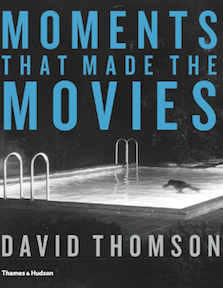By Svetlana Alpers
In the old-fashioned bookstore where I found this book, books on film are shelved with drama rather than with photography. Film as narrative counts more than film as pictures. But, having spent a lifetime writing about the art of painting, I must admit that I like slow movies which allow you to feel that you can savor each and every frame. One might say it is a question of describe versus narrate.
David Thomson is not into film theory (which has an important place in American universities these days), nor is he a journalistic-critic like Pauline Kael. His way of writing might rather be called experiential. With his huge knowledge of and fascination with the movies, he simply tells you what he has seen, what he thinks about it, what he thinks of film in general, and leaves it to you to make up your own mind. A great thing about Thomson is that he leaves things open.
What attracted me to this particular book was the emphasis on moments. I took that to mean the individual frames or pictures from movies would be addressed. I was not disappointed, but the book is not only that. The notion of moment gives focus to the book, to the looking (the many gripping individual frames as illustrations) and to the writing: the close-up of Margaret Sullavan’s face, for example, looking into her mail box for a letter that is not there in Lubitsch’s The Shop Around the Corner (1940); or two shots of Burt Lancaster and Tony Curtis in The Sweet Smell of Success (1957) about which Thomson comments The moment of the film is these two men taking razors to each other, and loving the malice . . .It’s this tortuous bond that is fascinating; the opening scene of Citizen Kane when Agnes Moorehead seated at a table, is selling her son Charles (seen out the window playing in the snow) to the bank about which, thinking of the end of this film, Thomson remarks, It is an American lesson that the one thing you never get means more than all the things you obtain and amass.
A sub-text of the book is such wise words about America by this British-born film-goer. About Meet Me in St. Louis, which opened in November 1944, he notes the film’s endorsement of the American devotion to staying home which is, however, set in a culture that impresses the rest of the world by being based in change, chance, and making a brave departure. In discussing Murnau’s Sunrise (1927), he remarks on the characters who look at a screened world and long to be there: It is a very American energy that tries to overcome destiny through sheer ambition or wanting. Or, speaking of Henry Fonda victimized by a scheming Barbara Stanwyck in The Lady Eve: 1941 was a good year in which the war between the sexes threatened to be as interesting and influential as the other war. Tossed off with grace and ease, such remarks leave one with much to think about art, but also about life.
The overall sense of the book is captured in the highlighted bit of text appended to the discussion of Mizoguchi’s Sancho the Bailiff: All films are about the way people look at the world. However, as Thomson admits in a characteristic aside: As I compose this book, I am beginning to realize that many of my moments turn on story. He goes on to propose that perhaps film has served as a transition between the novel and what will come after.
The stories on which his moments turn are varied. Some are internal to the script, but many play back on the lives of the particular actors and actresses cast to play particular roles. Of Margaret Sullavan at the mail-box he remarks: She went deaf, too early, she was depressed, and she killed herself at the age of fifty. Is it fanciful to predict that simply from her agonized face in the mailbox? Or of the coupling of Curtis with Lancaster: Did anyone hear the gay subtext then? I don’t know or care, because I think time and again movies can be out of control of the several people making them.
The films are presented in chronological order, and I must admit as it comes up to our own time I felt myself less on track with the films being discussed: are there simply so many more films being made that a consensus on what matters is no longer so easy? This book is not only a good read, but offers much to look at and leaves one with much to ponder.
Svetlana Alpers, an artist, critic and renowned art historian, is professor emerita of the history of art at the University of California, Berkeley and a visiting scholar in the Department of Art History at New York University.




